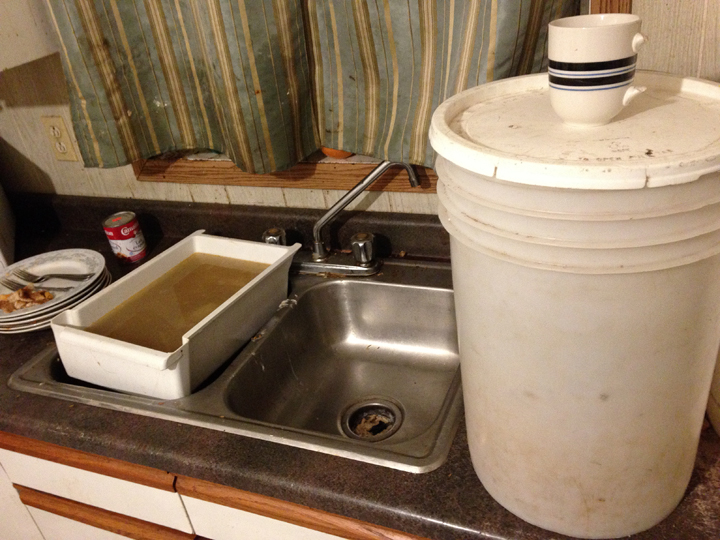WINNIPEG – Internal federal documents estimate it will cost $165 million to replace government-issued slop pails with modern indoor plumbing on four of Canada’s poorest reserves, but only a fraction of that has been budgeted.

Regional reports from Aboriginal Affairs and Northern Development Canada and obtained by The Canadian Press say $22 million was budgeted in 2011 to install rudimentary indoor plumbing in hundreds of homes in a cluster of northern Manitoba reserves known as Island Lake.
The reports date back to the fall of 2013 and were received under access-to-information legislation.
They say upgraded homes were outfitted with basic plumbing hooked up to individual water and sewage tanks. Although the reports repeatedly say much more money is needed for a community sewage system, no new money has been budgeted in more than three years.
“The project costs exceed available funding,” states a report dated March 2014.
READ MORE: Manitoba one of worst places for First Nations to live
A spokesperson for Aboriginal Affairs Minister Bernard Valcourt said the minister was not available for comment and did not provide anyone to answer questions.
Emily Hillstrom sent an emailed statement saying the government has made progress over the past four years, with updated plumbing and new water trucks, to improve the situation on the reserves.
- B.C. to ban drug use in all public places in major overhaul of decriminalization
- 3 women diagnosed with HIV after ‘vampire facials’ at unlicensed U.S. spa
- Solar eclipse eye damage: More than 160 cases reported in Ontario, Quebec
- ‘Super lice’ are becoming more resistant to chemical shampoos. What to use instead
“We recognize there is more work to be done and we will continue to work with the First Nations to build on the tangible progress accomplished so far,” she wrote.
The Island Lake community — made up of St. Theresa Point, Wasagamack, Garden Hill and Red Sucker First Nations — came under a global microscope during the H1N1 flu outbreak in 2009. There were hundreds of cases of the flu, mostly in children, on the remote reserves.
Chiefs blamed a lack of running water and overcrowding for the rapid spread of the virus and studies later backed them up.
“Preparations for remote First Nations communities prior to future outbreaks should include … attention to fundamental health determinants, including housing conditions such as overcrowding, access to potable water and sanitation,” said a study published in the Canadian Journal of Public Health in April 2012.
As part of its response to the outbreak, the federal government sent body bags to the reserves, raising the ire of chiefs. They said that when they asked for help bring running water to half the homes on the reserves, Ottawa sent 1,000 slop pails to use as toilets.
Jonathan Flett, executive director of the Island Lake Tribal Council, said the upgrades that have been done are a Band-Aid solution. With up to 18 people living in one home, sewage tanks fill up fast, he said.
“Eighteen people have to go 18 times a day, maybe twice,” he said.
The reserves don’t have enough water and sewage trucks to keep up with demand and there is nowhere to store them out of the cold. All outdoor water tanks have heaters to keep them from freezing, which adds to already soaring hydro bills, Flett said.
READ MORE: Winnipegger lives without running water on Manitoba First Nation
The government reports say installing the kind of indoor plumbing found in other municipalities doesn’t come cheap.
“Many houses in the Island Lake communities do not have indoor plumbing and in some cases there is no space for a bathroom,” the reports repeatedly state.
“Houses must be retrofitted with indoor plumbing before they can be connected to water and waste-water systems. This requires additional time, funds and considerable planning. The location of these communities, on the Canadian Shield, makes piped systems more costly to install.”
An internal report dated Sept. 30, 2013, suggested the federal government would not be paying for the upgrades and hinted the reserves — the majority of which are under financial co-management — would have to find a way to pay for the projects themselves.
“The region will soon be engaging the Island Lake Tribal Council in discussions about the need to access private capital,” the report said. “It is anticipated a considerable amount of protest will be received.”
The reserves don’t have the ability to raise their own cash without borrowing funds from elsewhere in their budgets, Flett said.
“That will create a problem for our communities.”
Grand Chief David Harper with Manitoba Keewatinowi Okimakanak, which represents the province’s northern First Nations, said the upgrades done so far aren’t enough.
There are still 400 homes without any form of running water, he said. New plumbing in other homes, housing elders and the sick, won’t last long in the harsh Island Lakes climate, he added.
First Nations people deserve the same access to running water as those living in municipalities off reserve, Harper added.
“It’s not good enough.”



Comments